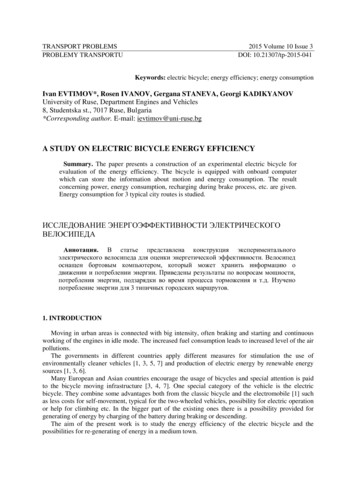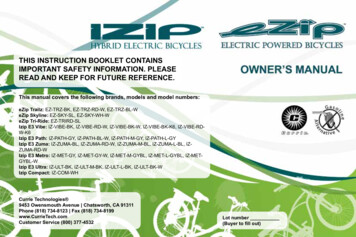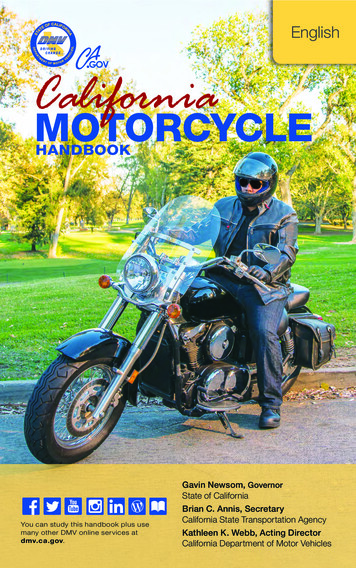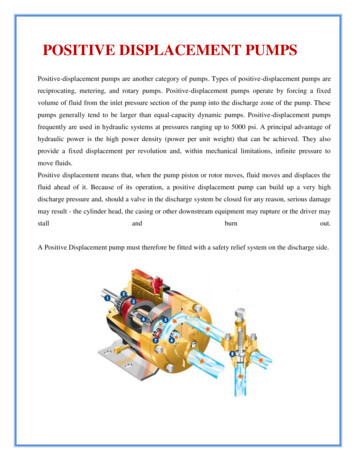
Transcription
TRANSPORT PROBLEMSPROBLEMY TRANSPORTU2015 Volume 10 Issue 3DOI: 10.21307/tp-2015-041Keywords: electric bicycle; energy efficiency; energy consumptionIvan EVTIMOV*, Rosen IVANOV, Gergana STANEVA, Georgi KADIKYANOVUniversity of Ruse, Department Engines and Vehicles8, Studentska st., 7017 Ruse, Bulgaria*Corresponding author. E-mail: ievtimov@uni-ruse.bgA STUDY ON ELECTRIC BICYCLE ENERGY EFFICIENCYSummary. The paper presents a construction of an experimental electric bicycle forevaluation of the energy efficiency. The bicycle is equipped with onboard computerwhich can store the information about motion and energy consumption. The resultconcerning power, energy consumption, recharging during brake process, etc. are given.Energy consumption for 3 typical city routes is studied.ИССЛЕДОВАНИЕ ЭНЕРГОЭФФЕКТИВНОСТИ ннотация. В статье представлена конструкция ческого велосипеда для оценки энергетической эффективности. Велосипедоснащен бортовым компьютером, который может хранить информацию одвижении и потреблении энергии. Приведены результаты по вопросам мощности,потребления энергии, подзарядки во время процесса торможения и т.д. Изученопотребление энергии для 3 типичных городских маршрутов.1. INTRODUCTIONMoving in urban areas is connected with big intensity, often braking and starting and continuousworking of the engines in idle mode. The increased fuel consumption leads to increased level of the airpollutions.The governments in different countries apply different measures for stimulation the use ofenvironmentally cleaner vehicles [1, 3, 5, 7] and production of electric energy by renewable energysources [1, 3, 6].Many European and Asian countries encourage the usage of bicycles and special attention is paidto the bicycle moving infrastructure [3, 4, 7]. One special category of the vehicle is the electricbicycle. They combine some advantages both from the classic bicycle and the electromobile [1] suchas less costs for self-movement, typical for the two-wheeled vehicles, possibility for electric operationor help for climbing etc. In the bigger part of the existing ones there is a possibility provided forgenerating of energy by charging of the battery during braking or descending.The aim of the present work is to study the energy efficiency of the electric bicycle and thepossibilities for re-generating of energy in a medium town.
132I. Evtimov, R. Ivanov, G. Staneva, G. Kadikyanov2. DISCRIPTION OF THE ЕXPERIMENTAL ELECTRIC BICYCLEFor the purposes of the research, a team from the Ruse University has worked out an experimentalelectric bicycle [2] based on a Bulgarian bicycle and electric elements. The general structure of theelectric bicycle is shown on fig. 1.The electric bicycle is operated by BLDC electric motor 5 with a nominal power of 500W, built-inthe front wheel. It is operated by lithium ion battery 3. The battery has a working tension of 36V,capacity 9Ah and a weight of 3,5kg. The battery contains 324Wh electric energy. The total weight ofthe electric bicycle is 24,4kg.The parts for operating and control are assembled on the handlebar (fig. 2, 3, 4). The controller 4optimizes the working regimes of the electric motor and the regime of regenerative braking.The autopilot 1 (fig. 4) provides a constant speed of the electric bicycle thus giving a possibility tofree the right hand from the speed regulation lever 2 (fig. 3). The regenerative stopping is operated bya separate button 2 (fig. 4) aiming to eliminate the eventual switch on of the mechanical brake system.Fig. 1. General view of the electric bicycle: 1 – frame; 2 – back wheel with a chain mechanism; 3 – battery; 4 –controller; 5 – electric motor; 6 – handlebarРис. 1. Общий вид электрического велосипеда: 1 – рама; 2 – заднее колесо с цепным механизмом; 3 –аккумулятор; 4 – контроллер; 5 – электромотор; 6 – рульFig. 2. General view of the electric bicycle handlebar: 1 – board computer; 2 – right handle; 3 – left handleРис. 2. Общий вид руля электрического велосипеда: 1 – бортовой компьютер; 2 – правая руковятка; 3 –левая рукоятка
A study on electric bicycle energy efficiency133Fig. 3. Operating elements on the right handle: 1 – an indicator for the discharge of the battery; 2 – lever forspeed regulation; 3 – a button for switching on/of the electric supplyРис. 3. Органы управления на правой рукоятке: 1 – индикатор разрядки аккумклятора; 2 – рычаг длярегулировки скорости; 3 – кнопка переключения вкл/выкл электропитанияFig. 4. Operating elements on the left handle: 1 – cruise control; 2 – the button for regenerative stoppingРис. 4. Органы управления на ревой рукоятке: 1 – круиз-контроль; 2 – кнопка для During braking and descending the electric motor works in a generative regime and charges thebattery.The board computer can register and show on a display the following parameters (fig. 5): the tension in V and the used capacity in Ah of the battery, the power in W of the electric motorand the speed of movement in km/h (fig. 5a); the tension of the battery, the power of the electric motor the speed of movement and therunning distance in km (fig. 5b); the tension of the battery, the power and the current of the electric motor in A and the usedcapacity of the battery (fig. 5c); the total used energy from battery in Wh and the used energy per 1km in Wh/km (fig. 5d); the minimum and maximum current in the electric motor and the minimum tension of thebattery (fig. 5e); the maximum and average speed of movement in km/h and the total time for movement in hrs,m and s (fig. 5f); the total number of charges, the total used capacity of the battery and the total running distance(fig. 5g).
134I. Evtimov, R. Ivanov, G. Staneva, G. Kadikyanovа)b)c)d)e)f)g)Fig. 5. Registered parameters from the board computerРис. 5. Регистрируемые параметры при помощи бортового компьютера3. RESULTS AND ANALYSIS3.1. Studying the energy consumptionThe energy consumption of the electric bicycle has been studied during different working regimes.There have been made experiments on a horizontal road in two directions with a five time repeatingat a constant speeds from 5 to 30km/h. The total weight of the electric bicycle and the cyclist 99,4 kg.The power P from the electric motor at different speed V of the electric bicycle is shown at fig. 6.The energy consumption E per 1km at different constant speeds V is shown at fig. 7.3.2. Study on the regenerative braking of the electric bicycleAt serial production of the electric bicycles and the sets on the market, the regenerating braking isachieved by the levers for activation of the front and the back brake. At the first starting of the leveronly the regenerating braking is switched on and after that depending on the power of pressing of thelever is achieved the desired brake delay, accordingly from the two braking systems – the electric andthe mechanical.Due to the fact that the mechanical braking system has a separate operation (the braking system ofeach wheel is operated by a separate lever) it is possible for the realization of the following ways forusing the braking systems:
A study on electric bicycle energy efficiency135Fig. 6. Dependence of the used motor power P by the speed VРис. 6. Зависимость используемой мощности двигателя P от скорости VFig. 7. Dependence of the energy consumption E by the speed VРис. 7. Зависимость потребления энергии E от скорости V1. Regenerative braking through starting of one of the levers for operating of the braking mechanismsof the wheels (fig. 8). regenerative braking and switched on braking mechanism of the front wheel; regenerative braking and switched on braking mechanism of the back wheel;2. Regenerative braking and switched on braking mechanism of both wheels (fig. 9).Fig. 8. Forces balance during regenerative braking and without braking for one wheelРис. 8. Баланс сил в течение регенеративного торможения и без торможения на одном колесе
136I. Evtimov, R. Ivanov, G. Staneva, G. KadikyanovFig. 9. Forces balance during regenerative braking and switched on braking mechanisms of both wheelsРис. 9. Баланс сил в течение регенеративного торможения и включения тормозных механизмов на обоихколесахAt fig. 8 and 9 are indicated the weight G, the rolling resistance force of the front Ffп and the rearFf3 wheels and the air resistance force Fв during braking process of the electric bicycle on a horizontalarea. The resistance forces Ffп, Ff3 and Fв are directed against the inertia force Fa and it is not possibleto use the entire kinetic energy of the electric bicycle for generating of electric energy.At present there are not enough researches for the effectiveness of the regenerative braking of theelectric bicycles in urban areas. In [8] it is indicated that depending on the conditions of moving andthe slopes of the streets, the regeneration of energy varies from 6 to 14%. The experiments made incity of Ruse during a covered distance of 215 km at some of the routes of public transport aregeneration of 5,5% is obtained.The full stop only by electric motor, without using the mechanical brake is impossible. At thebeginning there is only regenerating braking and after that it is necessary to switch on some of thebraking systems to achieve full braking.There have been experiments made at different initial speed and only regenerative braking has beenperformed. The results from the studies are presented at fig. 10. Each full braking or speed reductionthrough the electric motor increases the run of the electric bicycle and the exploitation time of themechanical brake system.Fig. 10. Dependence of the regenerating capacity in the battery Cрег by the initial speed of braking VsРис. 10. Зависимость емкости регенерации в аккумуляторе Cрег от начальной скорости торможения Vs
A study on electric bicycle energy efficiency137Fig. 11. Dependence of the regenerative current Ip by the speed of the electric bicycle VРис. 11. Зависимость тока регенерации Ip от скорости электрического велосипеда VIt is possible in the infrastructure of the urban area to be realized descending with a speed reductionpossibility through the electric motor. With this regard there have been performed experiments ofdescending at different speed. The results from the experiments are shown at fig. 11. At the differentvalues of constant speed V is reported the regenerated current Ip which charges the electric battery.From this characteristics it is seen that upon descending with speed of 25km/h in a regeneratingregime for 60s (the slope is 420 m long) in the battery will be regenerated 0,17Ah. At 9Ah batterycapacity, this regenerated capacity is 2%.3.3. Studying the energy consumption for typical routes in the conditions of a medium size townFor the study of the energy efficiency of the electric bicycle there have been chosen three typicalroutes in the town of Ruse (population 150 000) with a different profile but with heavy traffic. Theyare shown on fig. 12 14. For their visualization a virtual map [11] has been used.The three routes were passed by two group experiments. Firstly, at the beginning without the helpof the cyclist and starting only by using the electric motor for acceleration. Again the same routes havebeen passed also with the help of the cyclist though the bicycle pedals only at starting until reaching aspeed of 5km/h. All the experiments have been started with fully charged battery. The results areshown on table 1.There has been an experiment done also for determination of the operating range of the bicycleduring day time period with less traffic (Sunday morning). The average results from route 1 showedthat with one charge of the battery, the electric bicycle passes a distance of 34,77km in urbanconditions, without using the regenerative braking. The maximum achieved speed was 35,4km/h andthe average speed - 23,8km/h. For the whole pass of the route, the electric bicycle has used 390,49 Whof energy and average per km – 11,2Wh/km. For the bicycles designed abroad with working tension of36V and similar battery capacity of 9-10 Ah, the operating range for 1 charge of battery isapproximately 20 – 25 miles or 32 – 40 km [8, 9, 10]. This fact shows a similar energy consumption ofthe studied bicycle and a good fit of the obtained experimental results for the range in this research andfrom other authors [8 - 10].4. CONCLUSIONSFrom the carried out research and the analyses of the results, the following conclusions could bemade:1. Without regeneration of the energy in urban conditions the range of the electric bicycle is about35km.Considering the average value of the regenerating energy in a town of Ruse, the run of theelectric bicycle could be increased from 5 to 10%. At day time periods with not so heavy traffic,the run of the electric bicycle could be increased with about 11% due to the less number of brakingand accelerations.
138I. Evtimov, R. Ivanov, G. Staneva, G. KadikyanovFig. 12. Route 1: Railway Station – Danube Bridge and backРис. 12. Маршрут 1: Вокзал – мост через Дунай и обратноFig. 13. Route 2: Railway Station – Drujba 3 and backРис. 13. Маршрут 2: Вокзал – Дружба 3 и обратно
A study on electric bicycle energy efficiency139Fig. 14. Route 3: Railway Station – River Station and backРис. 14. Маршрут 3: Вокзал – Речной вокзал и обратноTable 1Results from the trialsParametersPassed distance S, kmEnergy consumption per 1kmpassed way, Wh/kmRegenerated energy, %Maximum speed on the route Vmax, km/hAverage speed on the route Vср,km/h,Time for route passing, min, sRoutes, passed without helpat startingRoutes, passed with help 810,731,624,522,818.422,421,320,636 min,46 s15 min,5s14 min,5s42 min,10 s16 min,16 s12 min,36 s2. The studies showed that in a town like Ruse, the use of electric bicycle instead of other vehicles byone person could reduce the air pollutions up to 10 times compared to the electromobiles and up to15 times compared to the conventional cars. Those values concern the air pollutions generated onlydue to motion and exclude the other parts like pollutions due to production of the car or bicycle,due to disassembling of the old machine etc. The effect of air pollutions reduction could not be sostrong because of a parallel replacing a number of conventional bicycles with electric, which willincrease pollutions. At the moment it is not possible to predict how significant will be the influenceof replacing.3. At speed of 15 to 25km/h the used power of the electric motor is from 100 to 300W and the energyconsumption is from 7 to 12Wh/km which is 6 to 23 times less than the energy consumption of theelectromobiles produced now.
140I. Evtimov, R. Ivanov, G. Staneva, G. Kadikyanov4. There is a bigger effect from the regeneration of energy on the routes including slopes. Forexample on the normal route 1 the regeneration is about 5%, but at routes 2 and 3 including slopesthe regeneration reaches about 10%.5. The level of increasing the effectiveness of the regenerative braking depends on the roadinfrastructure for moving of bicycles and electric bicycles and chosen by the cyclist regimes forspeed reduction and мов, И. & Иванов, Р. Електромобили. Русе: Русенски Университет „Ангел Кънчев“.2011 [In Bulgarian: Evtimov, I. & Ivanov, R. Electromobiles. Ruse: Ruse University „AngelKanchev”. 2011].Евтимов, И. & Иванов, Р. & Вълов, Н. Изследване разхода на енергия на електровелосипедпри различни режими на движение. МНК BulTrans. Созопол. 2012. P. 212-216 [In Bulgarian:Evtimov, I. & Ivanov, R. & Valov, N. Research on the energy consumption by electric bicycle atdifferent moving regimes. Proceedings of ISC BULTRANS. Sozopol. 2012].The Netherlands projects for combining the sun energy with bicycle alleys. Available ng resources. Available at: http://www.metrotransit.org/bike-options.aspx.Bike Safety as Social Justice. Available at:http://raisethehammer.org/article/1407/bike safety as social justice.Pi Mobility. Available at: http://picycle.com/sustainability/.Urban Active Travel: More European Bikes. Available 51/travel/Urban Active Travel%3A More European Bikes.Watt Hours; Calculating E-bike Range. Available at: https://www.electricbike.com/watt-hours/Energy Efficient Electric Bikes. Available at: -bike.html.Speed, Distance, and Energy Consumption. Available та на България с улици, адреси, маршрут. Available at: http//www.bgmaps.com.Received 11.03.2014; accepted in revised form 18.08.2015
of the cyclist and starting only by using the electric motor for acceleration. Again the same routes have been passed also with the help of the cyclist though the bicycle pedals only at starting until reaching a speed of 5km/h. All the experiments have been started with










